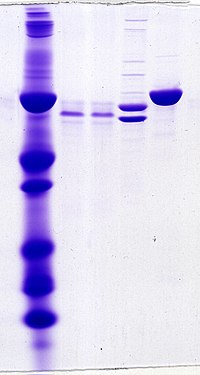
Photo from wikipedia
OBJECTIVE We evaluated the diagnostic value of cerebrospinal fluid oligoclonal bands in individuals less than 18 years of age. METHODS In a nationwide population-based setting, we retrieved data on 2055 children's… Click to show full abstract
OBJECTIVE We evaluated the diagnostic value of cerebrospinal fluid oligoclonal bands in individuals less than 18 years of age. METHODS In a nationwide population-based setting, we retrieved data on 2055 children's oligoclonal band examination, including concordant cerebrospinal fluid biomarkers, during 1994 to 2017. Case ascertainment was by review of medical records and diagnostic codes. We used Fisher's exact test to explore distribution differences of oligoclonal band positivity in acquired demyelinating syndromes (ADS) before and after age 12 years and calculated the sensitivity, specificity, positive predictive value, and negative predictive value of oligoclonal bands to distinguish ADS from the other diagnostic groups. RESULTS Median age at oligoclonal band examination was 15.2 years (range = 1.8 to 18.0), and 10% had presence of cerebrospinal fluid oligoclonal bands. Oligoclonal band positivity was the highest in ADS (52%), but it was age dependent: 21% in children with ADS before age 12 years and 68% in children aged 12 through 17 years (P < 0.0001) owing to the higher incidence of multiple sclerosis in the latter. Cerebrospinal fluid oligoclonal bands were not predictive of ADS before age 12 years compared with the other diagnostic groups. However, cerebrospinal fluid oligoclonal bands in children aged 12 through 17 years were highly predictive of ADS compared with central nervous system infections and non-ADS immune-mediated central nervous system diseases (positive predictive value: 0.89; 95% confidence interval = 0.82 to 0.94; P < 0.0001), but negative oligoclonal bands were not discriminatory (negative predictive value: P = 0.17). CONCLUSIONS In a clinical setting, cerebrospinal fluid oligoclonal band examination may be of higher yield in children aged 12 through 17 years if there is clinical suspicion of multiple sclerosis, and in such circumstances a positive test supports a diagnosis of multiple sclerosis.
Journal Title: Pediatric neurology
Year Published: 2019
Link to full text (if available)
Share on Social Media: Sign Up to like & get
recommendations!